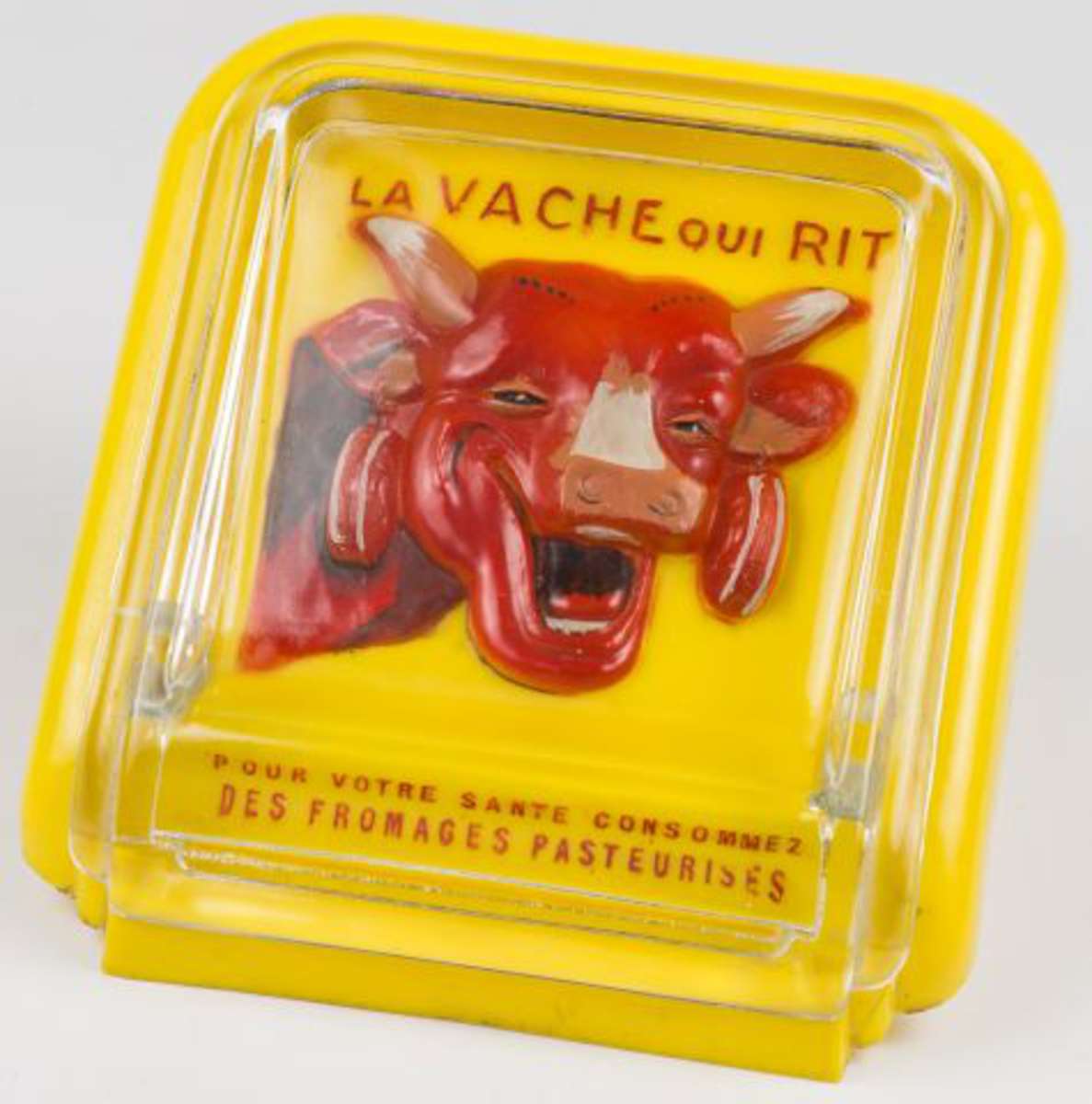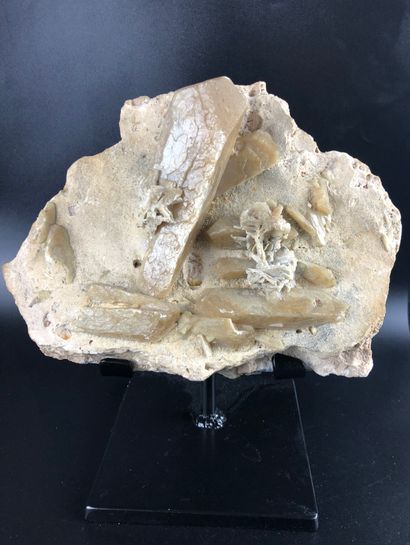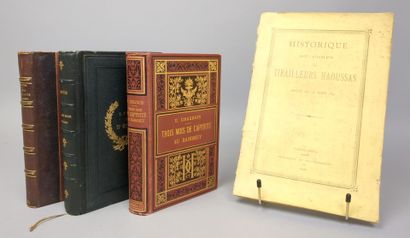la célèbre plaque de chêne pétrifié connue sous le nom de "Papillon", Moyen Miocene, Juntura Formation, Stinking Water Pass, localité située près de Buchanan, Oregon, USA THE FAMOUS "BUFFERFLY" PETRIFIED OAK Ce magnifique spécimen bien connu par les spécialistes est une trouvaille géologique excessivement rare. Sa détermination nous permet de l'identifier comme un chêne pétrifié parfaitement préservé par la minéralisation, et en provenance de l'Oregon. Il existe dans le monde à peine une demi douzaine de pièces de cette qualité. Ce bois a été découvert, tranché et poli très finement jusqu'à l'obtention d'un aspect miroir, par le célèbre collectionneur Jim Burnett. L'aspect exceptionnel de la pièce résulte de ce beau velours cerné par des nuances miel-or. Le bois montre réellement l'aspect d'un papillon avec deux parties distinctes formant les ailes séparées par un veinage crème. Le grain minéralisé du bois est fin. On distingue parfaitement les anneaux de croissance de l'arbre. Les dépôts géologiques de bois fossile de la Juntura formation présentent le plus beau chêne pétrifié du monde. Ce sont les cendres volcaniques qui ont entouré d'un linceul minéral les troncs qui se sont couchés sous le souffle des éruptions et l'eau minéralisée qui a finalement entrepris la pétrification de ces bois en remplaçant chaque cellule de bois par un grain minéral. Cette substitution a été si parfaite que chaque détail s'est retrouvé dans la version minérale obtenue du bois. Ce sont les hautes concentrations de fer et de manganèse qui ont concouru à donner à ce bel exemplaire il y a maintenant quelques 16 millions d'années, cet aspect esthétique faisant appel à de nombreuses teintes chaudes. Ce bois dit "Papillon" est l'un des plus recherchés du monde pour son aspect et sa qualité. On peut en admirer un exemplaire au Musée des Sciences Naturelles de Houston, USA. This striking specimen, well-known by specialists, is an exceedingly rare geological find. It is a piece of petrified oak from Oregon, perfectly preserved by mineralization. Only half a dozen or so logs of this quality exist in the world. Found in the Stinking Water Creek Basin of Oregon and professionally cut and polished to achieve a mirror-like quality in 1978 by the famous collector Jim Burnett, this piece displays a velvety black face surrounded by rich shades of golden honey. Parted lengthwise by a cream-coloured vein, it displays a natural butterfly-shaped form. The mineralized wood grain is fine, and one can distinguish perfectly the tree's growth-rings. The deposits of wood fossil of the Juntura region provide what is arguably the most beautiful petrified wood in the world, the prized "golden-oak". After the late Oligocene / early Miocene period, the ancestral Cascades volcanoes spewed tons of ash into the atmosphere, large quantities of which settled in Oregon. Some logs from the oak woodland were buried by sediment before they could decompose. Incorporated into the deepening layers of sediment, ground water dissolved silica from the volcanic ash and carried it through the logs. This solution filled the plant cell walls and crystallized into the mineral quartz. This substitution process was often so exact that every detail of the log's original surface can be seen, and, as in this rare case, the internal cell structures. High concentrations of manganese and iron in the solution during the petrification process 16 million years ago gave the petrified wood this highly aesthetically pleasing play of colours in warm nuances. The unique "Butterfly" petrified oak is one of the most prized and most collected petrified woods in the world. Another similarly rare log specimen can be found in the renowned Houston Museum of Natural Sciences. 75 cm dans sa plus grande largeur, épaisseur 3,5 cm ; 29,25 in
la célèbre plaque de chêne pétrifié connue sous le nom de "Papillon", Moyen Miocene, Juntura Formation, Stinking Water Pass, localité située près de Buchanan, Oregon, USA THE FAMOUS "BUFFERFLY" PETRIFIED OAK Ce magnifique spécimen bien connu par les spécialistes est une trouvaille géologique excessivement rare. Sa détermination nous permet de l'identifier comme un chêne pétrifié parfaitement préservé par la minéralisation, et en provenance de l'Oregon. Il existe dans le monde à peine une demi douzaine de pièces de cette qualité. Ce bois a été découvert, tranché et poli très finement jusqu'à l'obtention d'un aspect miroir, par le célèbre collectionneur Jim Burnett. L'aspect exceptionnel de la pièce résulte de ce beau velours cerné par des nuances miel-or. Le bois montre réellement l'aspect d'un papillon avec deux parties distinctes formant les ailes séparées par un veinage crème. Le grain minéralisé du bois est fin. On distingue parfaitement les anneaux de croissance de l'arbre. Les dépôts géologiques de bois fossile de la Juntura formation présentent le plus beau chêne pétrifié du monde. Ce sont les cendres volcaniques qui ont entouré d'un linceul minéral les troncs qui se sont couchés sous le souffle des éruptions et l'eau minéralisée qui a finalement entrepris la pétrification de ces bois en remplaçant chaque cellule de bois par un grain minéral. Cette substitution a été si parfaite que chaque détail s'est retrouvé dans la version minérale obtenue du bois. Ce sont les hautes concentrations de fer et de manganèse qui ont concouru à donner à ce bel exemplaire il y a maintenant quelques 16 millions d'années, cet aspect esthétique faisant appel à de nombreuses teintes chaudes. Ce bois dit "Papillon" est l'un des plus recherchés du monde pour son aspect et sa qualité. On peut en admirer un exemplaire au Musée des Sciences Naturelles de Houston, USA. This striking specimen, well-known by specialists, is an exceedingly rare geological find. It is a piece of petrified oak from Oregon, perfectly preserved by mineralization. Only half a dozen or so logs of this quality exist in the world. Found in the Stinking Water Creek Basin of Oregon and professionally cut and polished to achieve a mirror-like quality in 1978 by the famous collector Jim Burnett, this piece displays a velvety black face surrounded by rich shades of golden honey. Parted lengthwise by a cream-coloured vein, it displays a natural butterfly-shaped form. The mineralized wood grain is fine, and one can distinguish perfectly the tree's growth-rings. The deposits of wood fossil of the Juntura region provide what is arguably the most beautiful petrified wood in the world, the prized "golden-oak". After the late Oligocene / early Miocene period, the ancestral Cascades volcanoes spewed tons of ash into the atmosphere, large quantities of which settled in Oregon. Some logs from the oak woodland were buried by sediment before they could decompose. Incorporated into the deepening layers of sediment, ground water dissolved silica from the volcanic ash and carried it through the logs. This solution filled the plant cell walls and crystallized into the mineral quartz. This substitution process was often so exact that every detail of the log's original surface can be seen, and, as in this rare case, the internal cell structures. High concentrations of manganese and iron in the solution during the petrification process 16 million years ago gave the petrified wood this highly aesthetically pleasing play of colours in warm nuances. The unique "Butterfly" petrified oak is one of the most prized and most collected petrified woods in the world. Another similarly rare log specimen can be found in the renowned Houston Museum of Natural Sciences. 75 cm dans sa plus grande largeur, épaisseur 3,5 cm ; 29,25 in














Try LotSearch and its premium features for 7 days - without any costs!
Be notified automatically about new items in upcoming auctions.
Create an alert